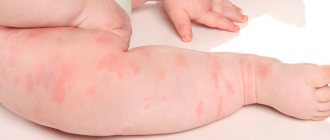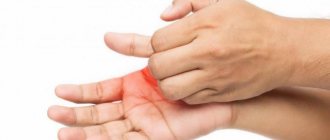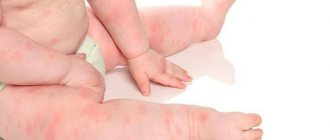Urticaria is a rather unpleasant disease that affects both children and adults equally. It manifests itself in the form of a rash, blisters and blisters on the body, which, in addition to the unsightly aesthetic effect, itch and itch. When a person first gets sick with it, it is not surprising that he begins to wonder whether urticaria is contagious? When asked whether urticaria is contagious in adults, doctors answer unequivocally - no.
Urticaria is one of the types of allergic reactions of the body to any irritant. It has been scientifically proven that no allergy can in any way be transmitted from person to person in everyday life. But some people still doubt this, so the question of how and whether hives are transmitted is worth looking into in more detail.
[smartcontrol_youtube_shortcode key=”hives” cnt=”1" col=”1" shls=”false”]
Why are people so concerned about this issue?
The fact is that urticaria immediately catches the eye, forcing a person to wrap himself in clothes even in the warm season. But bad luck, some parts of our body, such as the face, neck, hands and others, simply cannot be hidden in long sleeves, but life forces us to go to work, study, or just outside. For some, hives last only a couple of days, while others suffer from the disease for several weeks. Since it does not pose anything dangerous to others, no doctor will issue a sick leave to a patient with urticaria. Some people who are completely ignorant of medicine may begin to gossip about a sick person; he may become an object of gossip and conversation. They just don't know whether hives are contagious or not. Of course, this is caused solely by illiteracy and poor manners of talkers, but, nevertheless, medical illiteracy must be eliminated. Let's figure out whether urticaria is contagious.
Causes
It should be noted that there is no particular cause for concern. So far, none of the doctors have provided any compelling arguments indicating that urticaria can infect, for example, the person sitting next to you.
Let's consider the questions about what urticaria is, whether it is contagious or not, in more detail.
It's no secret that the source of most diseases are fungi, viruses, pathogenic bacteria, and helminths. At the same time, if you come into contact with a person who has this kind of illness, you can become infected yourself. The nature of the occurrence of urticaria is different - it is a certain type of reaction of the skin to internal and external irritants. In other words, the disease in question is a form of allergic reaction.
The above disease progresses due to the fact that a substance, histamine, is produced in skin cells. It is its excess amount that leads to the formation of blisters of pale pink and red shades. As a rule, the appearance of such formations is accompanied by itching and burning.
Symptoms of urticaria
- Rash. It can be located either symmetrically, in certain areas of the human body, or merge into a continuous crust. It happens on the stomach, arms, legs, buttocks, tongue, face, neck, hands, feet, legs. That is, on almost any part of the human body.
- Blisters are noticeable.
- The rash is incredibly itchy and itchy. However, it is categorically not recommended to scratch these rashes, if only because you can get carried away and tear the skin literally “to the meat” and cause an infection.
- Some people may experience chills bordering on fever.
- Poor appetite, lethargy, lethargy, lack of mood, apathy.
- Concern about your condition.
- Some people may lose consciousness, but this is mostly caused by worry about their own health.
- Many people experience, if not pain, then a feeling of discomfort in the throat.
- The blisters disappear almost before our eyes after the patient takes the proper measures.
[sma[smartcontrol_youtube_shortcode key=”is hives contagious” cnt=”1" col=”1" shls=”false”]
When is urticaria possible?
Is urticaria transmitted by airborne droplets? This question worries people who have experienced rashes and itching.
The cause of the development of skin rashes is not only infectious diseases, but also internal problems of the body - a failure of the immune system, hormonal disorders, food, allergies to medications, household allergens (for example, animal hair, dust, pollen).
Infection with a severe infectious disease is not always enough to cause urticaria. The cause of infectious urticaria is most often a viral disease. In this case, you should be wary of infection. However, in this case, everything depends on the individual characteristics of the immune system.
An organism suffering from an infectious disease may not trigger the mechanism that produces antibodies to allergens, and it will not develop a skin reaction.
But it is possible that a person suffering from an infection will tend to produce antibodies, as a result of which the skin will not react to the disease.
The appearance of urticaria is influenced not by the infection itself, but by the individual characteristics of the body.
Why does this disease occur?
Urticaria can occur for various reasons, the most common of which are:
- The body's reaction to medications that were used either incorrectly or without a doctor's prescription.
- Reaction to toxic substances entering the body.
- Urticaria, which occurs as an independent disease. It occurs in people with extremely poor health.
- Urticaria, which occurs as a reaction to unfavorable environmental conditions: cold, heat, excess moisture, solar energy.
- Urticaria as a reaction of the body to food.
- Sometimes the disease occurs as a signal that a hormonal imbalance has occurred, or indicates that a person is suffering from cancer.
- The disease also occurs as an allergy to facial and body care products and decorative cosmetics.
Attention! Some children develop urticaria due to diseases such as scarlet fever, measles or rubella. In this case, we can talk about infection directly with the underlying disease rather than rubella. Although, the likelihood that an adult in contact with a sick child will become infected is negligible. But a sick child should be isolated from a group of children, since urticaria is transmitted in childhood, and with it the underlying disease, infection.
There's no need to panic
We have already briefly answered the question of why urticaria occurs. Whether this disease is contagious or not - judge for yourself. It should be noted that the above disease can be divided into chronic and acute. The latter option, as confirmed by medical research, is more often characteristic of the younger generation, but chronic urticaria usually affects people of more mature age.
Thus, the answer to the question of whether hives is contagious can be answered with confidence in the negative. This is also confirmed by the fact that this disease can be transmitted from generation to generation, while “viral” diseases are not inherited.
Why is urticaria not a contagious disease?
Hives appear because a person's skin releases histamine, an enzyme that causes an allergic reaction as a signal that something is wrong.
Attention! Note to uninformed people who continue to worry about their health - it is very easy to distinguish hives from other contagious rashes. The rash on the human body is very similar to a nettle burn; the name of the disease speaks for itself. Contagious hives are simply two things that don't go together.
Urticaria is not a contagious disease also because it is simply an individual reaction of the body to any irritant. You can become infected with a disease that is transmitted by viruses, bacteria, fungi, helminths, is infectious in nature, etc. Urticaria is not one of them.
Many people are really concerned about their own health and whether hives are transmitted, so a red rash on the skin of someone they've just spoken to can cause them a whole lot of anxiety. This is not surprising, since many rashes are truly contagious. Naturally, a person begins to draw in his imagination terrible pictures of a painful illness. Taking care of one's own health evokes only respect and approval, but nevertheless, every person, even without a medical education, should be aware of the symptoms of allergies.
[smartco[smartcontrol_youtube_shortcode key=”can you get hives” cnt=”1" col=”1" shls=”false”]>Can you get hives from another person?
When meeting a person whose face smells red, or discovering itchy areas of redness on their face, everyone will ask themselves: “Is this thing contagious?” And only after some time or after a medical consultation will it become clear that this is a common urticaria.
Urticaria and its types
Urticaria is a manifestation of the body's reaction to a foreign agent in the form of local redness of the skin, accompanied by severe itching. It's simply an allergy.
This process got its name due to the similarity of the zones of hyperemia with a nettle burn. From the outside, urticaria seems like a terrible disease to others that can be contracted. And doctors cannot always make a diagnosis quickly and correctly.
Any average person will shudder at the sight of hives and try to avoid contact. Having decided that this is something very contagious, the sick person himself will strive to isolate himself from others.
But if it's hives, is it contagious? Is it transferable to another person? Is she dangerous to others?
There are two types of urticaria: acute and chronic.
Acute urticaria most often occurs in children. If it lasts for a month and a half or more, then it is already called chronic urticaria. Either this is true urticaria, that is, an independent diagnosis, or it is a symptom of some other pathology.
An attack of acute urticaria can be caused by exotic food, insect bites, contact with poisonous plants, the period of convalescence after acute respiratory viral infection, and the use of medications.
The development of chronic urticaria is caused by:
- any adverse environmental factors;
- parasitic infections;
- diseases of autoimmune origin;
- diseases of the internal secretion organs;
- any types of chronic infections;
- history of allergic disease (bronchial asthma, atopic dermatitis, hay fever).
Under the influence of an irritating agent, the destruction of mast cells begins to occur in the body. Under the influence of released histamine, a cascade of allergic reactions develops.
Urticaria in adults is characterized by a long-term persistent course. The spread of edema to the mucous membranes of the respiratory and digestive organs is especially dangerous; difficulty breathing, up to an attack of suffocation, or nausea and vomiting may occur.
The causes of urticaria in adults may be:
- any stressful situations - from neuropsychic reactions to environmental influences (aquagenic, cholinergic, adrenergic);
- physical contact with an irritating object, that is, direct contact;
- Causeless or idiopathic urticaria - the cause has not been established.
In the body of any person, a breakdown of immune defense factors can occur. And even a previously harmless allergen can have a damaging effect, which will manifest itself as hives.
Clinical picture
The development of the disease is acute. Against the background of complete well-being, red spots suddenly appear on the face or chest, or anywhere else, protruding above the skin and accompanied by itchy skin. Such zones of hyperemia can merge and cover the entire surface of the skin.
Children are characterized by an increase in body temperature to hectic levels, accompanied by a headache. Severe itching of the skin precedes the appearance of blisters, so it is very important not to miss the moment and to be in the reliable hands of doctors in time.
Is urticaria transmitted from a sick person to a healthy person?
Despite the fact that there are many reasons for this type of allergic reaction, it is safe to say that hives are not transmitted from person to person. This disease is strictly individual and is the property of each patient.
With a disease such as urticaria, all manifestations remain on the skin and do not have visceral manifestations. There is no reason to worry about a disorder in the functioning of the body as a whole. The skin and mucous membranes form a tandem for the development of the clinical picture.
There is no need to be afraid of the appearance of people suffering from urticaria. Undoubtedly, it looks remarkable and does not cause aesthetic pleasure, but it is worth remembering that anyone can get hives. And to prevent this from happening, you should follow certain recommendations.
What should you do to avoid getting hives?
- You should be careful about food products, since there are a lot of low-quality counterfeit products in stores. It is necessary to avoid eating foods high in preservatives, dyes and dietary supplements, and also minimize contact with exotic fruits and vegetables. This will reduce the chances of encountering allergens.
- If you have a history of chronic diseases of the gastrointestinal tract, dynamic observation by a doctor is recommended, and it is also important to follow an appropriate diet. Any exacerbation of the disease can provoke skin rashes.
- Treatment with antibacterial drugs should be started only as prescribed by the attending physician and strictly follow the recommended dosages and duration of treatment. Most experts believe that antibiotic treatment should be carried out in parallel with the intake of probiotics and eubiotics.
- It is necessary to sanitize all foci of chronic infection (oral cavity and teeth, ENT organs - ears, nose, throat, fungal infections of the nails and skin of the feet). Long-term persistent infection weakens the immune system and leads to its imbalance, thereby increasing susceptibility to allergens.
- Any acute viral infections should be treated until complete recovery, following all the recommendations of the treating doctor. Treatment without interruption from work does not achieve the desired effect, so the allergenic alertness of the immune system is significantly reduced in an asthenized body.
- To stabilize the nervous system, you should pay attention to auto-training techniques and meditation.
If the tension is too great, you should seek help from a psychotherapist. Prolonged stress, a nervous environment at work, and conflicts in the family lead to the destruction of the body's defense systems. In the absence of timely help, allergen attacks achieve their goals, which leads to the development of urticaria. - If the cause of urticaria is known - sun rays, cold air, medications, cosmetics, insects, etc., then it is important to carefully consider ways to protect against the effects of these adverse factors.
It's better to avoid them completely. Perhaps a change in climate zone will contribute to long-term remission.
To best protect children from developing acute urticaria, it is recommended to avoid all contact with possible food allergens. During the period of introducing complementary feeding to infants, it is important to follow all recommendations of pediatricians. You cannot make independent decisions during such an important period in children’s lives.
It is also very important to follow the treatment regimen prescribed by a specialist if acute urticaria occurs. This tactic will help avoid the disease becoming chronic. And the child will be completely cured, and in the future manifestations of urticaria will not bother him.
As a result, we can say with confidence that hives are not contagious. If there is contact with a person who is sick with this form of skin rash, then the spread of the disease will not occur. Urticaria in children is not a signal for introducing quarantine in educational institutions.
Source: https://allergiya03.com/zabolevaniya/krapivnica-zaraznaya-ili-net.html
Causes of the disease
The main reasons that can trigger the appearance of allergic rashes in children and adults are considered to be external factors.
Medical practice shows that a rash often occurs after direct contact of the body with an irritant, which is most often bacterial or fungal in nature.
The cause of the development of this disease can be an insect bite if a person is allergic to its enzymes and acid.
There are some factors whose impact on the human body can trigger the appearance of skin rashes:
- problems with the gastrointestinal tract and kidneys;
- exposure to the sun for a long time;
- long-term use of antibacterial drugs;
- disruptions in liver function;
- nervous stress and emotional overstrain;
- prolonged hypothermia of the body;
- previous viral infection;
- exposure to heat on the body for a long time.
It is important to identify the factor that provoked the development of urticaria in an adult or child, because the form of the pathology and the characteristics of its course will depend on it.
Types of urticaria that cannot be infected
There are several types of urticaria and each of them is a reaction to a specific allergen.
Hormonal
The cause of hormonal allergies is the reaction of the female body to hormones such as progesterone and estrogen. In some cases, this type of urticaria can occur due to constant stress, and in such a situation the hormone adrenaline or norepinephrine serves as a catalyst.
Food
Most often, food urticaria is diagnosed in children, and can become one of the accompanying symptoms of allergic dermatitis. Irritants such as post-vaccination reactions and gastrointestinal infections can provoke pathology. Characteristic symptoms of a food allergy include high fever, severe itching, a pink rash and general weakness.
Medicinal
Drug-induced urticaria can occur when taking medications. Characteristic symptoms of the disease can occur either 10-20 minutes later or several days after the therapy.
Most often, skin reactions in the form of rashes are provoked by medications such as penicillin antibiotics, antidepressants, non-steroidal anti-inflammatory drugs and acetylsalicylic acid.
Toxic
The main reason why toxic urticaria occurs is contact of human skin with toxic substances. In addition, exposure to irritating hairs of caterpillars, jellyfish, bee stings and nettle burns on the epidermis can provoke pathology.
Physical
In adults, a form of the disease such as physical urticaria can be diagnosed. The main reason for its development is considered to be intense physical activity and active sports. A characteristic symptom of this disease is swelling of blood vessels, low blood pressure and breathing problems.
Is hives contagious in adults?
If hives appear on the skin, whether such a disease is contagious or not should be checked with a dermatologist. In fact, urticaria is not a contagious disease, but transmission from a sick person to a healthy person is still possible. It should be remembered that in an adult, the development of such a pathology can be provoked by certain factors:
- disruption of the body's hormonal levels;
- contact with allergens at home;
- consumption of certain types of foods;
- entry into the body of bacteria, viruses and fungi.
All of these factors can provoke the development of pathologies that are transmitted from a sick person to a healthy one. Herpes can cause hives, but it cannot be transmitted from it. At the same time, herpes may be accompanied by the appearance of unpleasant symptoms, which are characteristic of urticaria.
How to protect your children?
When passing through the birth canal, a child can become infected with the same diseases that his mother suffers from. However, urticaria is not one of these pathologies and a child cannot become infected with it even if it occurs in the mother shortly before birth.
Urticaria is not transmitted to the baby through breastfeeding. If a rash appears on the mother’s body, it is imperative to consult a dermatologist to make a diagnosis.
When a rash appears on the skin under the influence of an endogenous irritant, there is a high risk of it entering the bloodstream. If this happens, a small amount of the irritating substance enters the milk, which the child subsequently eats.
An endogenous irritant enters the child’s body in this way and the result can be the appearance of urticaria.
One of the factors that causes diseases in young children is often infections, for example, a virus or rubella. Such pathologies do not pose a danger to adults. However, if a child comes into contact with a sick person, there is a high probability of transmission of infection and the appearance of a skin rash.
In order to reduce the likelihood of developing urticaria and protect your baby from infection, it is necessary to limit all his contacts with possible allergens. In addition, you should show a sick child to a specialist if unusual symptoms appear, because self-medication may result in the pathology becoming chronic.
It is important to monitor your child’s nutrition and avoid eating unhealthy foods and fast foods. It is necessary that the body receives a sufficient amount of vitamins and nutrients, which will have a positive effect on the functioning of the immune system.
Which hives are contagious?
Patients should know which hives are contagious and which are not. The cause of the development of pathology can be both diseases of an infectious nature and internal malfunctions in the body. The disease can be triggered by food, medications, toxins and other irritants.
The development of a severe infectious disease in a person is not always accompanied by the appearance of urticaria. Infectious urticaria can develop under the influence of viruses that enter the body. In such a situation, infection is possible, but it all depends on the individual characteristics of the organism.
If a patient has an infectious disease, then his body may not start the mechanism for producing antibodies to allergens and a skin reaction will not occur.
How is urticaria transmitted?
Experts have proven that skin rashes themselves do not pose a danger to others. The disease cannot be transmitted through the skin, since urticaria is the body’s reaction to an allergen or a sign of an infectious pathology.
At the same time, urticaria is one of those diseases that are inherited.
Only if the cause of the skin lesion is an infectious disease, then its transmission from a sick person to a healthy person by airborne droplets cannot be ruled out.
Skin rashes due to urticaria can be either single or multiple, and this depends on the state of the person’s immunity. If you have such a rash, you should definitely consult a doctor and ask questions about the disease, since urticaria is dangerous due to its very serious consequences. If there are indications, he will conduct a thorough examination and prescribe anti-allergy medications.
Source: https://allergik.info/zabolevaniya/krapivnitsa/mozhno-li-zarazitsya-krapivnitsej.html
How to deal with urticaria?
First of all, you need to take an antihistamine, it could be Tavegil, Suprastin, Diazolin, Dezal, etc.
In addition, diet is an integral part in the treatment of urticaria. It should be as natural as possible. It should be prescribed by a doctor, but, nevertheless, there are principles that should be followed.
- You can eat all cereals except semolina.
- If you consume fermented milk products, then only without any flavoring or aromatic additives (that is, you will have to exclude fruit yoghurts, glazed cheese curds, etc.).
- You can eat meat, but lean meat. It is advisable if it is poultry meat.
- You can eat any fruits and vegetables, with the exception of red ones.
- All types of bread and butter are indicated for consumption.
- You can’t eat heavy food, spicy, smoked, fatty, fried.
Clinical manifestations
There is no need to panic without understanding whether urticaria is transmitted from person to person.
Hives can affect people of any age. Its occurrence is unpredictable. It can occur acutely or become chronic. Acute urticaria is more often observed in children, and chronic urticaria is most often observed in women aged 20–60 years. Men are less likely to get the rash. This is associated with the characteristics of the nervous and endocrine systems.
The rash begins with itchy skin that spreads over large or small areas.
The rash can appear on any part of the body. At the site of scratching, redness (hyperemia) occurs, then blisters appear, like a nettle burn (hence the name). The blisters are round in shape with jagged edges or appear in the form of stripes that follow scratch marks. In color - pale in the center and reddish at the edges. Blisters can merge with each other, forming quite large areas. With severe rashes, an increase in body temperature to 38–39°C may be observed.
A feature of acute urticaria is its rapid development and disappearance without a trace over an interval of several minutes to several hours.
Chronic urticaria, accompanying systemic diseases, has a long course. Its manifestations on the skin become painful and may not disappear for more than 3 days, periodically returning again.
Characteristic blisters in a child can appear at any age under the influence of certain accompanying factors.
In children under 2 years of age, a rash most often occurs as a reaction to the introduction of a new food product into the diet or to direct contact with the skin of previously unfamiliar substances, such as washing powder, cream, lotion, powder, medicine, etc. According to its clinical The manifestations of urticaria in children are no different from rashes in adults.
If someone in the family has itchy blisters on the skin, then many begin to wonder whether hives in adults are contagious. Medicine gives an absolutely clear answer: urticaria in adults, like in children, is not contagious.
Sample diet menu for urticaria for 1 day
Breakfast.
Oatmeal with dried fruits, black tea with bread or biscuits.
Snack.
A glass of kefir or milk.
Dinner.
Pea soup, boiled potatoes with butter and herbs, baked chicken breast, compote or green tea.
Afternoon snack.
Two small baked apples, cottage cheese.
Dinner.
Zucchini stuffed with rice and vegetables/minced meat.
How to behave so as not to become infected with infectious diseases?
Just because urticaria is not a contagious disease does not mean that you can safely come into contact with all people with skin rashes. If you are not sure that the patient has urticaria, then you need to carefully follow preventive measures:
- Carefully observe the rules of personal hygiene.
- Monitor your own health and treat all diseases in a timely manner.
Is an allergic skin rash transmitted from person to person, is hives contagious or not?
Urticaria (urticaria) is the body’s reaction to any substances perceived as foreign. A characteristic symptom of the disease is a rash all over the body. This symptom often occurs with other diseases.
Is the disease contagious to others? Experts clearly answer this question in the negative. The disease is the body's response to an irritant.
However, the factors that triggered the onset of the disease are varied. If an allergy occurs in the presence of infectious diseases, then you can become infected with them. The appearance of urticaria in this case depends on the condition of the person and his immune system. Often, skin rashes appear in the presence of harmful viruses; they can also be transmitted from one person to another.
The appearance of nettle rash is due to the reaction of the body, not to infection.
Reasons for appearance
The main reasons for the appearance of such a disease are external factors. Most often this is direct contact with an allergic irritant; in some cases, such an irritant is fungal or bacterial in nature.
In addition, there are cases when hives were caused by an insect bite to which the person was allergic to enzymes and acid.
Some other reasons that trigger the appearance of a rash on the body:
- hypothermia for a long time;
- prolonged exposure to the sun;
- prolonged exposure to heat;
- previous viral infection;
- prolonged use of antibiotic drugs;
- liver dysfunction;
- nervous tension;
- disruption of the gastrointestinal tract and kidneys.
Important: the severity and form of the disease depends on the provoking factor.
You can't get infected
Is urticaria always dangerous for people? There are certain factors that cause rashes, but do not pose a danger to humans.
Factors:
- Medicines,
- Toxic substances,
- Natural phenomena (frost, sun),
- Food,
- Hormonal imbalances
- Malignant tumors.
Such factors are not contagious and cannot be transmitted from one to another. If hives arose as a result of a reaction to such irritants, then there is nothing to be afraid of - you cannot become infected with it.
The disease can occur during severe stress and depression. In such a situation, it is also not contagious to others.
Diagnostic methods
It is impossible to determine the cause of the blisters by visual inspection. Allergic rashes have many varieties, so in order to accurately make a diagnosis, you need to take a number of measures:
- laboratory test of blood composition - with urticaria, the number of eosinophils is increased;
- checking the concentration of immunoglobulins - the presence of allergies is indicated by high IgE;
- search for specific antibodies that the body produces in case of a negative reaction to certain foods.
Based on the test results, therapy is prescribed. If it turns out to be ineffective, the patient is referred for an examination of the lymph nodes, a biochemical blood test, and a urine test.
Contagiousness of urticaria in children
Is nettle rash in children dangerous for others? In preschool children, this disease is diagnosed quite often. The reason for this is that the immune system has not yet strengthened. Children often suffer from airborne infections.
Infections:
- Rubella,
- Piggy,
- Measles,
- Chickenpox,
- Diphtheria,
- Typhoid fever,
- Flu.
A child can become infected with viral diseases that can cause urticaria.
Virus:
- Cytomegalovirus,
- Herpes,
- ARVI.
Children are often diagnosed with helminthic infestations. Worms can be transmitted from person to person and cause the development of hives.
However, when infected with any disease, urticaria does not necessarily appear immediately. The disease occurs when the immune system is rather weakened. The disease can be inherited. Often the rash occurs in children whose parents are allergic.
If suspicious signs are detected in your baby, you must contact a medical facility to identify the exact allergy factors.
In what cases is the disease not dangerous?
The following forms of urticaria are considered non-contagious:
- medicinal – after using various medications (anti-inflammatory drugs, antibiotics), characteristic rashes occur;
- toxic - a rash develops as a result of the influence of toxic substances that enter the skin or inside the body;
- food - characteristic rashes occur after eating various foods;
- cholinergic – the development of blisters occurs under the influence of emotional overstrain and stress;
- demographic - the rash is localized at the site of mechanical irritation of the skin;
- rashes that appear under the influence of water, sun, heat, cold.
Contagiousness of urticaria in adults
What danger does urticaria in adults pose to people around them? An allergic reaction can occur for various reasons.
If there are viral diseases in adults, you can become infected not with urticaria, but with viruses. Whether an allergic response will manifest itself in such a situation depends on the state of the human body.
Transmission of rash from mother to child
During childbirth, the baby can become infected with various diseases from the mother. However, urticaria is not one of them. In a child under the age of six months, this phenomenon is diagnosed quite rarely. The reasons may be cosmetics, products consumed by the mother and ingested by the baby with milk.
One type of urticaria is miliaria. It appears as a result of irritation on the skin from sweat and mechanical damage.
Thus, a child cannot catch hives from the mother, but there may be other factors that influence this.
Stages of rash treatment
Is this disease dangerous? The disease does not pose a particular danger to humans. However, it requires care and adherence to the rules of therapy. In severe cases, it can cause Quincke's edema, which can be fatal. Treatment of urticaria includes certain stages.
Stages:
- Making a diagnosis, identifying the cause of the allergic reaction.
- The use of various medications - antihistamines, sedatives. External agents are used - creams, ointments, gels, solutions.
- The use of traditional medicine is allowed.
- In certain cases, it is advisable to use physiotherapeutic procedures.
- Be sure to prescribe a suitable diet during the treatment process, excluding foods that can cause allergies.
Treatment is carried out until complete recovery; the prescribed diet is followed for at least six months.
Prevention and conclusions
To avoid the appearance and recurrence of allergic urticaria, it is necessary to observe certain prevention.
Measures:
- Review your diet and eliminate allergy-causing foods.
- For prevention, you should periodically take antihistamines.
- When prescribing medications, you should carefully study the instructions for use, and if necessary, you should inform your healthcare professional about possible allergic reactions.
- Nervous shocks and stress should be avoided.
- It is worth treating all illnesses on time.
- It is necessary to give preference to natural cosmetics and hypoallergenic household chemicals.
- It is better to choose clothes from natural fabric.
- Contact with the allergenic substance should be avoided.
- When the first signs of allergic urticaria appear in a child, you should go to the hospital.
- It is necessary to adhere to hygiene rules.
If you follow simple rules, urticaria can be completely avoided.
conclusions
Is hives contagious? No, this disease cannot pass from one person to another. But by inheritance such a transition is possible.
Result:
- A nettle rash occurs in the presence of certain factors. With a good immune system, symptoms of the disease may not occur at all.
- It is impossible to contract the disease, but it is quite possible to catch viruses that can cause it.
- Nettle fever is not transmitted by airborne droplets; in this way, you can become infected with infections that cause it.
Thus, there is no need to be afraid of infection. If suspicious signs appear, you need to determine the reasons that caused it. Treatment is selected based on diagnostic results. Proper nutrition and a healthy lifestyle are very important.
Symptoms
To understand the issue of the contagiousness of urticaria, it is important to know the symptoms of this disease. The main difference of the disease is the sudden appearance of numerous bright pink blisters. The majority of rashes occur in the first hour and a very small number appear later.
After a few hours, the blisters may disappear completely, or the disease will make itself felt with a second wave of rash. But as for other infectious skin pathologies, the opposite is true: the rash appears, starting with several formations, then gradually increasing.
Chronic urticaria lasts for months, or even years. Depending on how affected the skin is, the patient’s general condition may remain within normal limits (except for itching). But in some cases, headaches, fever, and general malaise are possible.
Is this type of urticaria contagious? The answer to this question is, of course, negative. Chronic forms of this pathology are associated with autointoxication and are mainly characteristic of diseases of the gastrointestinal tract and liver, inflammatory foci in the tonsils and gall bladder, dental ailments and helminthic infestations.
Allergic skin lesions include childhood urticaria. It affects babies who are bottle-fed and those who are often fed foods that are inappropriate for their age.
The most complex form of the disease is Quincke's edema. It seems especially dangerous when it occurs in the larynx area. If timely assistance is not provided, the person or child may die.
The factors that provoke urticaria are different. Thus, those who do not tolerate cold well may experience cold urticaria. Failure to perceive ultraviolet radiation can cause solar urticaria.
For older people, this manifestation is possible through a sharp change in temperature. Toxic urticaria can occur as a result of contact with certain plants, animal insects, and fish.
Even the presence of a cat in the apartment can cause a sluggish chronic form of this pathology.
It is quite clear that in all of these cases, urticaria cannot be transmitted either by sneezing or shaking hands.
Source: //gidroz.ru/kozha/zarazna-li-krapivnica.html









